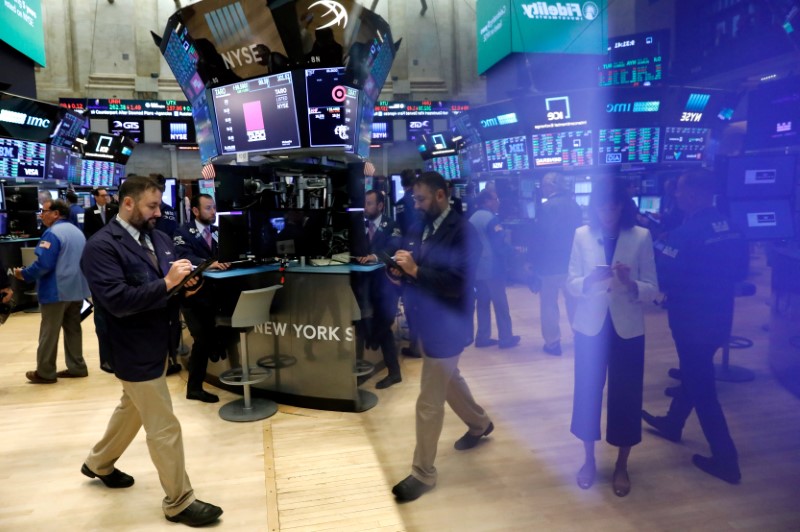(Refiles to fix ASX200 RIC, add FTSE futures RIC)
* Asian stock markets : https://tmsnrt.rs/2zpUAr4
* Australia bucks trend, closes up 7% after jobs package
* Nikkei leads rest of Asia lower, S&P and European futures rally
* Singapore eases monetary policy
* Oil on the slide as supply engulfs demand
By Wayne Cole and Alun John
SYDNEY/HONG KONG, March 30 (Reuters) - Asian shares slid on Monday as fears mounted that the global coronavirus shutdown could last for months although markets regained some lost ground late in the session with Australia posting a standout jump.
U.S. and European futures also turned upwards in the Asian afternoon, with E-Mini futures for the S&P 500 ESc1 up 1.1%, again after earlier losses, EUROSTOXXX 50 futures STXEc1 rallying 2% and FTSE futures FFIc1 1.5%.
Australia's benchmark ASX200 .AXJO saw a late surge, closing up 7% after Prime Minister Scott Morrison unveiled a $130 billion ($79.86 billion) package to help save jobs. other markets were down but trimmed earlier losses. Japan's Nikkei .N225 dropped 1.57%, Shanghai blue chips .CSI300 were down 0.94%, and there were sharper drops in Southeast Asia, with Singapore' benchmark index .STI down 2.95%. left MSCI's broadest index of Asia-Pacific shares outside Japan .MIAPJ0000PUS nearly flat.
"Markets in Asia are reacting to concerns about the knock-on economic impact of the coronavirus situation in Europe and North America, rather than Asian case numbers," said Suresh Tantia senior investment strategist at Credit Suisse (SIX:CSGN).
JPMorgan (NYSE:JPM) now predicts that global GDP could contract at a 10.5% annualised rate in the first half of the year.
"We continue to mark down 1H20 global GDP forecasts as our assessment of both the global pandemic's reach and the damage related to necessary containment policies has increased," said JPMorgan economist Bruce Kasman.
As a result, central banks have mounted an all-out effort to bolster activity with rate cuts and massive asset-buying campaigns, which have at least eased liquidity strains in markets.
China on Monday became the latest to add stimulus with a cut of 20 basis points in a key repo rate, the largest in nearly five years. also eased as the city-state's bellwether economy braced for a deep recession, while New Zealand's central bank said it would take corporate debt as collateral for loans. Catril, a senior FX strategist at NAB, said the main question for markets was whether all the stimulus would be enough to help the global economy withstand the shock.
"To answer this question, one needs to know the magnitude of the containment measures and for how long they will be implemented," he added. "This is the big unknown and it suggests markets are likely to remain volatile until this uncertainty is resolved."
DOLLAR NOT DONE YET
Bond investors looked to be bracing for a long haul with yields at the very short end of the Treasury curve turning negative and those on 10-year notes US10YT=RR dropping a steep 26 basis points last week to last stand at 0.68%.
That drop has combined with efforts by the Federal Reserve to pump more U.S. dollars into markets, and dragged the currency off recent highs.
Against the yen, the dollar was pinned at 107.74 JPY= , well off the recent high of 111.71. The euro edged back to $1.083 EUR= , after rallying more than 4% last week.
"Ultimately, we expect the USD will soon reassert itself as one of the strongest currencies," argued analysts at CBA, noting the dollar's role as the world's reserve currency made it a countercyclical hedge for investors.
"This means the dollar can rise because of the deteriorating global economic outlook, irrespective of the high likelihood the U.S. is also in recession."
The dollar's retreat had provided a fillip for gold, but fresh selling emerged on Monday as investors were forced to liquidate profitable positions to cover losses elsewhere. The metal was last off 0.23% at $1,613.6 an ounce XAU= . GOL/
Oil prices were again under water as Saudi Arabia and Russia showed no signs of backing down in their price war even as global transport restrictions hammered demand. O/R
Brent crude LCOc1 futures lost $1.42 to $23.51 a barrel, while U.S. crude CLc1 fell 83cents to $20.67.
<^^^^^^^^^^^^^^^^^^^^^^^^^^^^^^^^^^^^^^^^^^^^^^^^^^^^^^^^^^^ Asia stock markets
https://tmsnrt.rs/2zpUAr4 Asia-Pacific valuations
https://tmsnrt.rs/2Dr2BQA
^^^^^^^^^^^^^^^^^^^^^^^^^^^^^^^^^^^^^^^^^^^^^^^^^^^^^^^^^^^> (Editing by Sam Holmes and Jacqueline Wong)
